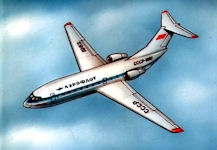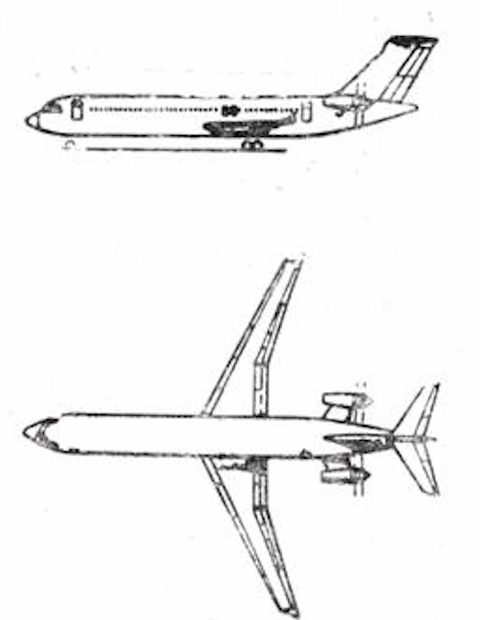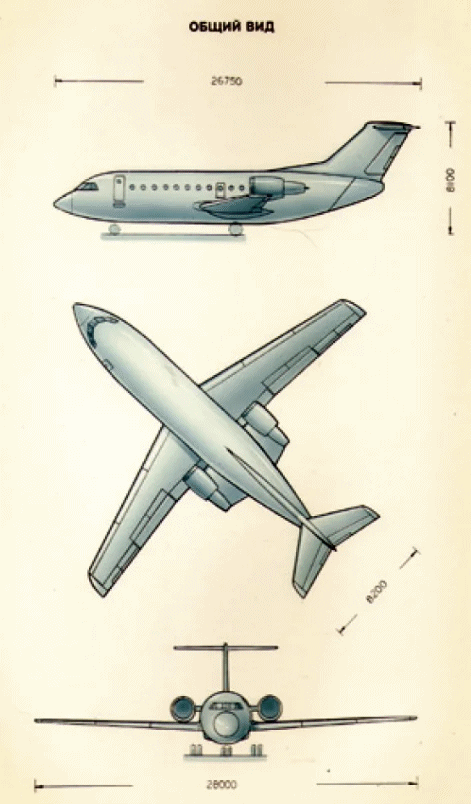Yak-46 project 1982
 The Yak-46 was an unrealized project of a turbojet passenger aircraft for local airlines, developed at the Yakovlev Design Bureau on the basis of the Yak-42 short- and medium-range mainline previously put into operation. Thus, Soviet aviation could get two different purpose aircraft, but with the same elements, which would reduce the cost of assembly and further maintenance of both aircraft. But the Yak-42 plane crash that occurred in 1982 led to the fact that their production was halted for two years, and the Yak-46 project was canceled altogether. Work on the project was discontinued in 1982 after the Yak-42 CCCP-42529 crash, which led to the temporary cessation of operation of this type of aircraft.
The Yak-46 was an unrealized project of a turbojet passenger aircraft for local airlines, developed at the Yakovlev Design Bureau on the basis of the Yak-42 short- and medium-range mainline previously put into operation. Thus, Soviet aviation could get two different purpose aircraft, but with the same elements, which would reduce the cost of assembly and further maintenance of both aircraft. But the Yak-42 plane crash that occurred in 1982 led to the fact that their production was halted for two years, and the Yak-46 project was canceled altogether. Work on the project was discontinued in 1982 after the Yak-42 CCCP-42529 crash, which led to the temporary cessation of operation of this type of aircraft.
In 1980, the Yak-42, a 120-seat airliner of the Design Bureau named after Yakovleva, who kept pace with the achievements of the world aviation industry and had high operational indicators, including due to the use of modern D-36 engines. Yak-42 planes were planned to be replaced by TU-134 airliners, which were gradually becoming obsolete. Thanks to the use of D-36 engines, a new aircraft with 120 seats was more economical to operate, and, accordingly, tickets for Soviet citizens would cost much less. Two in 1982 in Yakovlev Design Bureau decided to adapt the economical Yak-42 for regional transportation over short distances. So, the idea came up to create on the basis of the Yak-42 a shortened version of the aircraft called the Yak-46. The experience gained during the creation of the Yak-42 was proposed to be used to develop a new turbojet aircraft for local airlines, which would replace the An-24 turboprop and the Yak-40 jet.
The new aircraft received a shortened fuselage from the original Yak-42 with a diameter of 3.80 m with a cabin with six seats in a row. The length of the aircraft decreased from 36.38 m to 26.75 m. The T- tail was a reduced analogue of the Yak-42 plumage, the cockpit, avionics, air conditioning, engines and APUs were identical to the Yak-42. The number of engines was reduced from three to two, placed on the tail pylons, similar to the Tu-134 . The place of the inlet of the third (middle) engine was occupied by an auxiliary power unit placed in the tip of the rear fuselage.
A new swept wing was developed for the Yak-46, a smaller size compared to the Yak-42. Its sweep was reduced from 23 to 16 degrees along the leading edge to facilitate operation from short runways (for comparison, the Tu-134 had a sweep wing of 35 degrees in quarters of chords). Thus, the younger brother of the Yak-42 would need a runway of shorter length, which would make it possible to use the Yak-46 at almost all regional airfields of the Soviet Union. Otherwise, it was a complete analogue of the Yak-42 aircraft using most of its parts.
The designers proposed to shorten the fuselage of the Yak-42, and instead of 120 to install 78 passenger seats in it. At the same time, they arranged the seats on the new Yak-46, like the Yak-42, with six seats in a row - only 13 rows. Thus, the plane turned out to be shorter than the original by as much as 10 meters. The passenger compartment with a length of 10.87 m accommodated passengers in seats each with a seat pitch of 750 mm. A 4.8-meter-long luggage compartment was located under the passenger compartment. The Yak-46 lost the tail stairs used on the Yak-42. Instead, in the niche under the door in the front of the fuselage, a folding ramp with a railing was placed, similar to the option offered on Boeing passenger aircraft.
After the Yak-42 plane crash of the USSR-42529, which claimed 132 lives, the Yak-42 flights at Aeroflot were suspended until the circumstances were clarified, which negatively affected the image of the Yak-42 and served as one of the reasons for the cessation of work on the project; not a single car was produced.
| type | passenger plane |
| Developer | OKB named after Yakovlev |
| Status | project was closed in 1982 |
| Base model | Yak-42 |
| Manufacturing firm | OKB A.S. Yakovleva |
| type | short-range, narrow-body |
| Length | 26.75 m |
| Wingspan | 28 m |
| 1/4 chord sweep | 16 ° |
| Tail height | 8.1 m |
| Fuselage diameter | 3.80 m |
| Cabin Width | 3.60 m |
| Engines | 2 × 63.74 kN Progress D-36 |
| Cruising speed | 700 km / h |
| Top speed | 0.75 M (810 km / h) |
| Range of flight | 2500 km |
| Flight altitude | 9100 m |
| Runway length required | 1650 m |
| Maximum take-off weight | 32.5 t |
| Commercial load | 8.2 t |
| Number of passengers (economy) | 78 |
| Crew | 2 pilots and 1 flight engineer |


|
NEWSLETTER
|
| Join the GlobalSecurity.org mailing list |
|
|
|

